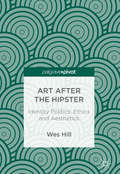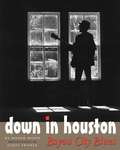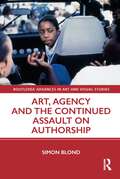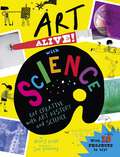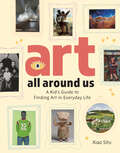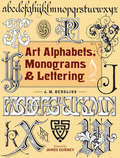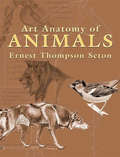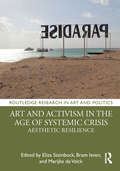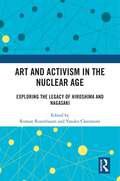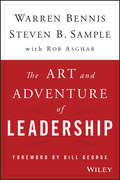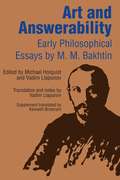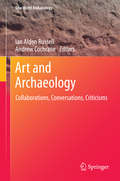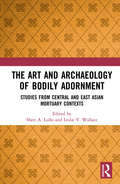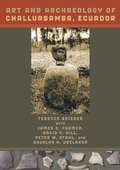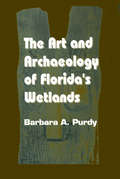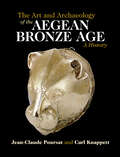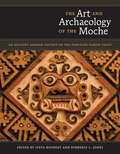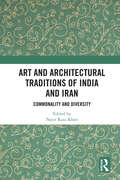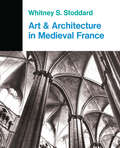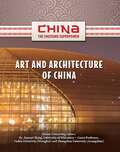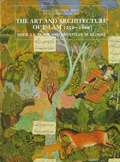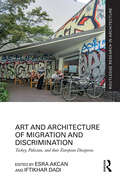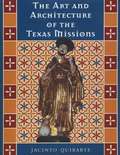- Table View
- List View
Art after the Hipster: Identity Politics, Ethics and Aesthetics
by Wes HillThis book examines the complexities of the hipster through the lens of art history and cultural theory, from Charles Baudelaire's fl#65533;neur to the contemporary "creative" borne from creative industries policies. It claims that the recent ubiquity of hipster culture has led many artists to confront their own significance, responding to the mass artification of contemporary life by de-emphasising the formal and textual deconstructions so central to the legacies of modern and postmodern art. In the era of creative digital technologies, long held characteristics of art such as individual expression, innovation, and alternative lifestyle are now features of a flooded and fast-paced global marketplace. Against the idea that artists, like hipsters, are the "foot soldiers of capitalism", the institutionalized networks that make up the contemporary art world are working to portray a view of art that is less a discerning exercise in innovative form-making than a social platform--a forum for populist aesthetic pleasures or socio-political causes. It is in this sense that the concept of the hipster is caught up in age-old debates about the relation between ethics and aesthetics, examined here in terms of the dynamics of global contemporary art.
Art Against Dictatorship: Making and Exporting Arpilleras Under Pinochet
by Jacqueline AdamsArt can be a powerful avenue of resistance to oppressive governments. During the dictatorship of Augusto Pinochet in Chile, some of the country's least powerful citizens-impoverished women living in Santiago's shantytowns-spotlighted the government's failings and use of violence by creating and selling arpilleras, appliquéd pictures in cloth that portrayed the unemployment, poverty, and repression that they endured, their work to make ends meet, and their varied forms of protest. Smuggled out of Chile by human rights organizations, the arpilleras raised international awareness of the Pinochet regime's abuses while providing income for the arpillera makers and creating a network of solidarity between the people of Chile and sympathizers throughout the world. Using the Chilean arpilleras as a case study, this book explores how dissident art can be produced under dictatorship, when freedom of expression is absent and repression rife, and the consequences of its production for the resistance and for the artists. Taking a sociological approach based on interviews, participant observation, archival research, and analysis of a visual database, Jacqueline Adams examines the emergence of the arpilleras and then traces their journey from the workshops and homes in which they were made, to the human rights organizations that exported them, and on to sellers and buyers abroad, as well as in Chile. She then presents the perspectives of the arpillera makers and human rights organization staff, who discuss how the arpilleras strengthened the resistance and empowered the women who made them.
Art, Agency and the Continued Assault on Authorship (Routledge Advances in Art and Visual Studies)
by Simon BlondThis book presents a counter-history to the relentless critique of the humanist subject and authorial agency that has taken place over the past fifty years. It is both an interrogation of that critique and the tracing of an alternative narrative from Romanticism to the twenty-first century which celebrates the agency of the artist as a powerful contribution to the wellbeing of the community. It does so through arguments based on philosophical aesthetics and cultural theory interspersed with case histories of particular artists. It also engages with a second issue that cannot be separated from the first. This is the question of what the role and purpose of art is in society. This has become particularly important since the 1990s because of the "social turn" in art in which it is claimed that the only valid role for art was one that had explicit social consequences. This book argues that a political role for art is valuable, but not the only one that can be envisaged nor indeed is it the most obvious or most important. Art has other social roles both as a means to engender empathy and community, and to re-enchant a world bereft of meaning and reduced to material values. The book will appeal to practising artists as well as scholars working in art history, philosophy, aesthetics, and curatorial studies.
Art Alive! with Science: Get creative with art history and science!
by Mary AuldExperience how art meets science, from the earliest cave paintings to today's advanced tech - and meet the innovative artists behind it all!In Art Alive! with Science, award-winning author Mary Auld explores moments from art history that have expanded our understanding of the way things work, such as the beautiful balance of forces in kinetic sculpture, the interplay of light and shadow in painting and puppetry and how Op Art tricks our brains and plays with our senses. Following each case study of astounding innovation, there is a creative project that applies the scientific learning to the reader's own art practice. The unique art style of illustrator Sue Downing is sure to draw in young artists, especially alongside the photos of each artist's work and contribution to the timeline of innovation. Perfect for children age 8 and up.Artists and science principles inside include:Introduction: Artists and scientists from cave painting to bronze castingThe art of anatomy with Myron's Discobolus (Discus Thrower)The science of illustration with Hildegard of Bingen and Abd al-Rahman al-SufiThe fantasy of flight with Leonardo da VinciThe drama of light with Caravaggio's chiaroscuro and wayang kulit shadow puppetryThe art of nature with Ustad Mansur and Maria Sibylla MerianThe image in perspective with Johannes Vermeer's The GeographerThe science of clouds with Luke Howard, Caspar David Friedrich and John ConstableThe sense of colour with expressionism and pointillismThe structure of flowers with Georgia O'KeeffeThe energy of sound with Paul Klee's PolyphonyThe balance of forces with Alexander Calder's kinetic sculpturesThe art of astronomy with Galileo, Lucien Rudaux and NASAThe art of light with Pablo Picasso, Gjon Mili and their famous light drawing collaborationThe art of illusion with Marina ApollonioThe science of materials with Anish KapoorThe structures of life with Dorothy Hodgkin and Conrad ShawcrossThe reactions of chemistry with Cai Guo-Qiang's explosion eventsThe dimension of time with Jen's Stark's fascinating and mathematical 30 Cubed
Art All Around Us: A Kid's Guide to Finding Art in Everyday Life
by Xiao SituFrom the self to the stars, art is all around us! Art is not just the paintings and sculptures we see in museums, but also things that surround us every day—family photos, decorations used during holidays or celebrations, even quilts and furniture that inhabit our homes. Throughout human history, people have created all kinds of objects to express who they are and what&’s important to them. Art All Around introduces young readers to some of the most vibrant and compelling art and artifacts from around the world. Increasingly, art historians are moving beyond a linear, chronological approach to teaching that has prioritized the Western canon and limited artworks to paintings and sculpture. Instead, they are exploring how objects across different mediums, cultures, and time periods produce &“conversations&” and connections within a broader web of global art. Art All Around includes thoughtfully chosen works from a variety of mediums, including photography, metalwork, pottery, textiles, furniture, and architecture, in addition to traditional paintings and sculpture. Each chapter features art objects from across different cultures and time periods to emphasize their thematic, stylistic, or functional commonalities within a wider web of global art production and ends with an activity page that enables readers to engage with the themes and objects more directly.
Art Alphabets, Monograms, and Lettering (Dover Art Instruction)
by J. M. BerglingChicago–based jewelry engraver J. M. Bergling (1866–1933) created thousands of letter styles, signets, monograms, and ciphers. A noted author on the subjects of lettering and heraldic design, Bergling created books that became standard references of his era. He assembled his first book, Art Monograms and Letters,with the hopes of inspiring other etchers, engravers, sign painters, and artisans. This volume contains selected illustrations from that publication in addition to his complete Art Alphabets and Lettering,which comprises 96 pages of layouts and letter styles ranging from simple to ornate. Commercial artists, designers, calligraphers, engravers, amateurs, and professionals will prize this exclusive edition as a source of high-quality images and alphabets. This reference book features an appreciative Foreword by artist and author James Gurney, which places Bergling's works in historical context.
Art Anatomy of Animals
by Ernest Thompson SetonA prolific author of books on wildlife, the great naturalist Ernest Thompson Seton was also an accomplished illustrator. Noting a dearth of general zoological anatomies for artists, he took it upon himself to create one. This volume is the result of his efforts. In it, he provides a definitive artist's-eye view of the exterior anatomy of animals, helping readers depict surface features such as hair or fur, as well as basic body and facial structures.Chapters cover a number of domesticated and wild species: the anatomy, size, and proportion of the lion, tiger, leopard, and other members of the cat family; bears (including the grizzly, European brown, American black, and the polar bear); as well as the camel, Indian elephant, and the caribou. Additional sections consider the horse in motion, the gallop of a dog, and bird feathering.One of the most widely consulted books on the subject, Art Anatomy of Animals will be a valuable addition to the libraries of both instructors and students of art.
Art and Activism in the Age of Systemic Crisis: Aesthetic Resilience (Routledge Research in Art and Politics)
by Marijke De Valck Eliza Steinbock Bram IevenThis book examines how renewed forms of artistic activism were developed in the wake of the neoliberal repression since the 1980s. The volume shows the diverse ways in which artists have sought to confront systemic crises around the globe, searching for new and enduring forms of building communities and reimagining the political horizon. The authors engage in a dialogue with these artistic efforts and their histories – in particular the earlier artistic activism that was developed during the civil rights era in the 1960s and 70s – providing valuable historical insight and new conceptual reflection on the future of aesthetic resilience. This book will be of interest to scholars in contemporary art, history of art, film and literary studies, protest movements, and social movements.
Art and Activism in the Nuclear Age: Exploring the Legacy of Hiroshima and Nagasaki
by Roman Rosenbaum Yasuko ClaremontThis book explores the contemporary legacy of Hiroshima and Nagasaki following the passage of three quarters of a century, and the role of art and activism in maintaining a critical perspective on the dangers of the nuclear age. It closely interrogates the political and cultural shifts that have accompanied the transition to a nuclearised world. Beginning with the contemporary socio-political and cultural interpretations of the impact and legacy of the destruction of Hiroshima and Nagasaki, the chapters examine the challenges posed by committed opponents in the cultural and activist fields to the ongoing development of nuclear weapons and the expanding industrial uses of nuclear power. It explores how the aphorism that "all art is political" is borne out in the close relation between art and activism. This multi-disciplinary approach to the socio-political and cultural exploration of nuclear energy in relation to Hiroshima/Nagasaki via the arts will be of interest to students and scholars of peace and conflict studies, social political and cultural studies, fine arts, and art and aesthetic studies.
The Art and Adventure of Leadership
by Steven B. Sample Warren Bennis Rob AsgharFor the first time, a top leadership scholar and a top leadership practitioner explore the true duties, demands, and privileges of leadership. Intellectual sparks flew when Warren Bennis, the "father" of modern leadership studies and Steven B. Sample, one of the most accomplished university presidents in recent history, came together for candid explorations of the forces that shape successful leaders and unsuccessful ones. The Art and Adventure of Leadership, their final collaboration, reveals the profound insights that the authors gained together over the 16 years in which they co-taught one of the most popular leadership courses in America. Here, each brings his own distinct vantage point as they address the mechanics and mysteries of leadership. The result is a unique examination of the journey of great leaders from momentary setbacks to ultimate success. It offers profound lessons on what determines the difference between failure and redemption for leaders. And it illuminates important and overlooked dimensions of great leaders ranging from Winston Churchill to Steve Jobs. Together, they explore why: A mature leader must grasp when it's healthy to risk failure, and when failure can't be tolerated at any cost Leadership isn't for everyone and requires a particular set of skills and competencies that are often glossed over in most management literature To succeed in an uncertain and fast-changing world, a shrewd leader must understand which aspects of human society change--and which aspects never change A mature, wise leader must seek a balance between high-minded ideals and the gritty realities and compromises that leaders face in their daily lives Above all, meaningful leadership remains a matter of character With incredible insight, this book examines why George Washington, Abraham Lincoln, and other giants were able to recover from failures, learn resilience, and prepare themselves for their moments of destiny. In so doing, it demonstrates and helps cultivate the leadership skills that you need to create your own most meaningful legacy. The Art and Adventure of Leadership is a unique look at leadership, and a critical resource for the leaders of tomorrow.
Art and Answerability
by M. M. BakhtinThis book contains three of Bakhtin's early essays from the years following the Russian Revolution, when Bakhtin and other intellectuals eagerly participated in the debates of the period.
Art and Archaeology: Collaborations, Conversations, Criticisms (One World Archaeology #11)
by Ian Alden Russell Andrew CochraneThis volume presents a collection of interdisciplinary collaborations between contemporary art, heritage, anthropological, and archaeological practitioners. Departing from the proceedings of the Sixth World Archaeological Congress's 'Archaeologies of Art' theme and Ábhar agus Meon exhibitions, it includes papers by seminal figures as well as experimental work by those who are exploring the application of artistic methods and theory to the practice of archaeology. Art and archaeology: collaborations, conversations, criticisms encourages the creative interplay of various approaches to 'art' and 'archaeology' so these new modes of expression can contribute to how we understand the world. Established topics such as cave art, monumental architecture and land art will be discussed alongside contemporary video art, performance art and relational arts practices. Here, the parallel roles of artists as makers of new worlds and archaeologists as makers of pasts worlds are brought together to understand the influences of human creativity.
The Art and Archaeology of Ancient Greece
by Judith M. BarringerThe Art and Archeology of Ancient Greece is an introductory-level textbook for students with little or no background in ancient art. Arranged chronologically in broad swathes of time, from the Bronze and Iron Ages through the Geometric, Archaic, Classical, and Hellenistic periods, and concluding with the Roman conquest of the Greek world, the textbook focuses on Greek art but also incorporates Near Eastern, Etruscan, and Roman objects. Judith M. Barringer examines a variety of media, analyzing marble and bronze sculpture, public architecture, and vase painting, as well as coins, domestic architecture, mosaics, terracotta figurines and reliefs, jewelry, and wall painting. This book adopts an approach that considers objects and monuments within their cultural contexts. * More than 500 illustrations, with over 400 in color and 13 maps, including specially commissioned photographs, maps, plans, and reconstructions * Includes text boxes, chapter summaries and timelines, and detailed glossary * Looks at Greek art from perspectives of both art history and archaeology, giving students an understanding of the historical and everyday context of art objects
The Art and Archaeology of Bodily Adornment: Studies from Central and East Asian Mortuary Contexts
by Sheri A. Lullo Leslie V. WallaceThe Art and Archaeology of Bodily Adornment examines the significance of adornment to the shaping of identity in mortuary contexts within Central and East Asia and brings these perspectives into dialogue with current scholarship in other worldwide regions. Adornment and dress are well-established fields of study for the ancient world, particularly with regard to Europe and the Americas. Often left out of this growing discourse are contributions from scholars of Central and East Asia. The mortuary contexts of focus in this volume represent unique sites and events where identity was visualized, and often manipulated and negotiated, through material objects and their placement on and about the deceased body. The authors examine ornaments, jewelry, clothing, and hairstyles to address questions of identity construction regarding dimensions such as gender and social and political status, and transcultural exchange from burials of prehistoric and early historical archaeological sites in Central Asia, China, Korea, and Japan. In both breadth and depth, this book will be of interest to students and scholars interested in the archaeology, art, and history of Central and East Asia, as well as anyone interested in the general study of dress and adornment.
Art and Archaeology of Challuabamba, Ecuador
by Terence GriederChalluabamba (chī-wa-bamba)--now a developing suburb of Cuenca, the principal city in the southern highlands of Ecuador--has been known for a century as an ancient site that produced exceptionally fine pottery in great quantities. Suspecting that Challuabamban ceramics might provide a link between earlier, preceramic culture and later, highly developed Formative period art, Terence Grieder led an archaeological investigation of the site between 1995 and 2001. In this book, he and the team of art historians and archaeologists who excavated at Challuabamba present their findings, which establish the community's importance as a center in a network of trade and artistic influence that extended to the Amazon River basin and the Pacific Coast. Art and Archaeology of Challuabamba, Ecuador presents an extensive analysis of ceramics dating to 2100-1100 BC, along with descriptions of stamps and seals, stone and shell artifacts, burials and their offerings, human remains, and zooarchaeology. Grieder and his coauthors demonstrate that the pottery of Challuabamba fills a gap between early and late Formative styles and also has a definite connection with later highland styles in Peru. They draw on all the material remains to reconstruct the first clear picture of Challuabamba's prehistory, including agriculture and health, interregional contacts and exchange, red-banded incised ware and ceramic production, and shamanism and cosmology. Because southern Ecuador has received relatively little archaeological study, Art and Archaeology of Challuabamba, Ecuador offers important baseline data for what promises to be a key sector of the prehistoric Andean region.
The Art and Archaeology of Florida's Wetlands
by BarbaraA. PurdyWaterlogged archaeological sites in Florida contain tools, art objects, dietary items, human skeletal remains, and glimpses of past environments that do not survive the ravages of time at typical terrestrial sites. Unfortunately, archaeological wet sites are invisible since their preservation depends upon their entombment in oxygen-free, organic deposits. As a result, they are often destroyed accidentally during draining, dredging, and development projects. These sites and the objects they contain are an important part of Florida's heritage. They provide an opportunity to learn how the state's earliest residents used available resources to make their lives more comfortable and how they expressed themselves artistically. Without the wood carvings from water-saturated sites, it would be easy to think of early Floridians as culturally impoverished because Florida does not have stone suitable for creating sculptures. This book compiles in one volume detailed accounts of such famous sites as Key Marco, Little Salt Spring, Windover, Ft. Center, and others. The book discusses wet site environments and explains the kinds of physical, chemical, and structural components required to ensure that the proper conditions for site formation are present and prevail through time. The book also talks about how to preserve artifacts that have been entombed in anaerobic deposits and the importance of classes of objects, such as wooden carvings, dietary items, human skeletal remains, to our better understanding of past cultures. Until now this information has been scattered in obscure documents and articles, thus diminishing its importance. Our ancestors may not have been Indians, but they contributed to the state's heritage for more than 10,000 years. Once disturbed by ambitious dredging and draining projects, their story is gone forever; it cannot be transplanted to another location.
The Art and Archaeology of the Aegean Bronze Age: A History
by Jean-Claude PoursatThe Art and Archaeology of the Aegean Bronze Age offers a comprehensive chronological and geographical overview of one of the most important civilizations in human history. Jean-Claude Poursat's volume provides a clear path through the rich and varied art and archaeology of Aegean prehistory, from the Neolithic period down to the end of the Bronze Age. Charting the regional differences within the Aegean world, his study covers the full range of material evidence, including architecture, pottery, frescoes, metalwork, stone, and ivory, all lucidly arranged by chapter. With nearly 300 illustrations, this volume is one of the most lavishly illustrated treatments of the subject yet published. Suggestions for further reading provide an up-to-date entry point to the full richness of the subject. Originally published in French, and translated by the author's collaborator Carl Knappett, this edition makes Poursat's deep knowledge of the Aegean Bronze Age available to an English-language audience for the first time.
The Art And Archaeology of the Moche: An Ancient Andean Society of the Peruvian North Coast
by Bourget Steve Jones Kimberly L.Renowned for their monumental architecture and rich visual culture, the Moche inhabited the north coast of Peru during the Early Intermediate Period (AD 100-800). Archaeological discoveries over the past century and the dissemination of Moche artifacts to museums around the world have given rise to a widespread and continually increasing fascination with this complex culture, which expressed its beliefs about the human and supernatural worlds through finely crafted ceramic and metal objects of striking realism and visual sophistication. In this standard-setting work, an international, multidisciplinary team of scholars who are at the forefront of Moche research present a state-of-the-art overview of Moche culture. The contributors address various issues of Moche society, religion, and material culture based on multiple lines of evidence and methodologies, including iconographic studies, archaeological investigations, and forensic analyses. Some of the articles present the results of long-term studies of major issues in Moche iconography, while others focus on more specifically defined topics such as site studies, the influence of El Niño/Southern Oscillation on Moche society, the nature of Moche warfare and sacrifice, and the role of Moche visual culture in decoding social and political frameworks.
Art and Architectural Traditions of India and Iran: Commonality and Diversity
by Nasir Raza KhanThis book presents a comprehensive overview of the historical and cultural linkages between India and Iran in terms of art and architectural traditions and their commonality and diversity. It addresses themes such as early connections between Iran, India and Central Asia; study of the Qutb Complex in Delhi; the great immigration of Turks from Asia to Anatolia; the collaboration of Indian and Persian painters; design, ornamentation techniques and regional dynamics; women and public spaces in Shahjahanabad and Isfahan; the noble-architects of emperor Shah Jahan's reign; development of Kashmir’s Islamic religious architecture in the medieval period; role of Nur Jahan and her Persian roots in the evolution of the Mughal Garden; synthesis of Indo-Iranian architecture; and confluence of Indo-Persian food culture to showcase the richness of art, architecture, and sociocultural and political exchanges between the two countries. Bringing together a wide array of perspectives, it delves into the roots of connection between India and Iran over centuries to understand its influence and impact on the artistic and cultural genealogy and the shared past of two of the oldest civilizations and regional powers of the world. With its archival sources, this book will be useful to scholars and researchers of medieval history, Indian history, international relations, Central Asian history, Islamic studies, Iranian history, art and architecture, heritage studies, cultural studies, regional studies, and South Asian studies as well as those interested in the study of sociocultural and religious exchanges.
Art And Architecture In Medieval France: Medieval Architecture, Sculpture, Stained Glass, Manuscripts, The Art Of The Church Treasuries
by Whitney S. StoddardThis is an English-language study on the architecture and art of medieval France of the Romanesque and Gothic periods between 1000-1500. In addition to essays on individual monuments there are general discussions of given periods and specific problems such as: why did Gothic come into being? Whitney Stoddard explores the interrelationship between all forms of medieval ecclesiastical art and characterization of the Gothic cathedral, which he believes to have an almost metaphysical basis.
Art and Architecture of China (China: The Emerging Superpower)
by Shelia Hollihan-ElliotChina has a rich artistic tradition extending back thousands of years. Art and Architecture of China surveys the art treasures of this vibrant civilization, from ancient and imperial China to today's People's Republic. The arts of each era are interpreted in the context of the life, culture, and politics of that era, offering insights to their meaning and showing how China's artistic output has reflected the development of Chinese society and thought. Art forms studied include ancient bronze ritual vessels and jade; the Three Perfections (calligraphy, poetry, and brush painting); ceramics and porcelain; sculpture; decorative and folk art; and modern, Western-influenced painting. Traditional Chinese architecture and town planning is also explored, revealing key technologies and design principles. In addition, today's interplay between traditional architecture and cutting-edge modernism is examined.
The Art and Architecture of Islam, 1250-1800
by Sheila S. Blair Jonathan M. BloomThe authors present a provocative essay on the varied legacies of Islamic art in Europe and the Islamic lands in the nineteenth and twentieth centuries.
Art And Architecture Of The Middle Ages: Exploring A Connected World
by Jill Caskey Adam S. Cohen Linda SafranArt and Architecture of the Middle Ages is a panoramic survey that focuses on the arts of medieval Europe, Byzantium, and the Islamicate world. From majestic monuments to exquisite tableware, Jill Caskey, Adam S. Cohen, and Linda Safran deftly guide readers over twelve centuries of art and architecture created by the diverse peoples and religious groups of western Eurasia and North Africa. This textbook, intended for a wide range of courses in the history of medieval art and architecture, uniquely features: • More than 450 color illustrations of fascinating works produced between ca. 250 CE and ca. 1450 CE • Coverage of secular and religious arts, including polytheistic, Zoroastrian, Jewish, Christian, and Islamic traditions • Informational text boxes on key issues and a glossary of terms • Diverse cultures interwoven in a single chronological framework • Five broad interpretive themes―artistic production, status and identity, connection to the past, ideology, and access to the sacred Complemented by a website (artofthemiddleages.com) with additional works, dynamic maps and timelines, podcasts, new primary-source translations, and more, Art and Architecture of the Middle Ages brilliantly expands and recalibrates the story of medieval art history.
Art and Architecture of Migration and Discrimination: Turkey, Pakistan, and their European Diasporas (Routledge Research in Architecture)
by Esra Akcan Iftikhar DadiThis book brings together essays by established and emerging scholars that discuss Pakistan, Turkey, and their diasporas in Europe. Together, the contributions show the scope of diverse artistic media, including architecture, painting, postcards, film, music, and literature, that has responded to the partitions of the twentieth century and the Muslim diasporas in Europe. Turkey and Pakistan have been subject to two of the largest compulsory population transfers of the twentieth century. They have also been the sites for large magnitudes of emigration during the second half of the twentieth century, creating influential diasporas in European cities such as London and Berlin. Discrimination has been both the cause and result of migration: while internal problems compelled citizens to emigrate from their countries, blatant discriminatory and ideological constructs shaped their experiences in their countries of arrival. Read together, the Partition emerges from the essays in Part I not as a pathology specific to the Balkans, Middle East, or South Asia, but as a central problematic of the new political realities of decolonization and nation formation. The essays in Part II demonstrate the layered histories and multiple migration paths that have shaped the experiences of Berliners and Londoners. This analysis furthers the study of modernism and migration across the borders of, not only the nation-state, but also class, race, and gender. As a result, this book will be of interest to a broad multidisciplinary academic audience including students and faculty, artists, architects and planners, as well as non-specialist general public interested in visual arts, architecture and urban literature.
The Art and Architecture of the Texas Missions
by Jacinto QuirarteBuilt to bring Christianity and European civilization to the northern frontier of New Spain in the seventeenth and eighteenth centuries...secularized and left to decay in the nineteenth century...and restored in the twentieth century, the Spanish missions still standing in Texas are really only shadows of their original selves. The mission churches, once beautifully adorned with carvings and sculptures on their façades and furnished inside with elaborate altarpieces and paintings, today only hint at their colonial-era glory through the vestiges of art and architectural decoration that remain. To paint a more complete portrait of the missions as they once were, Jacinto Quirarte here draws on decades of on-site and archival research to offer the most comprehensive reconstruction and description of the original art and architecture of the six remaining Texas missions--San Antonio de Valero (the Alamo), San José y San Miguel de Aguayo, Nuestra Señora de la Purísima Concepción, San Juan Capistrano, and San Francisco de la Espada in San Antonio and Nuestra Señora del Espíritu Santo in Goliad. Using church records and other historical accounts, as well as old photographs, drawings, and paintings, Quirarte describes the mission churches and related buildings, their decorated surfaces, and the (now missing) altarpieces, whose iconography he extensively analyzes. He sets his material within the context of the mission era in Texas and the Southwest, so that the book also serves as a general introduction to the Spanish missionary program and to Indian life in Texas.
